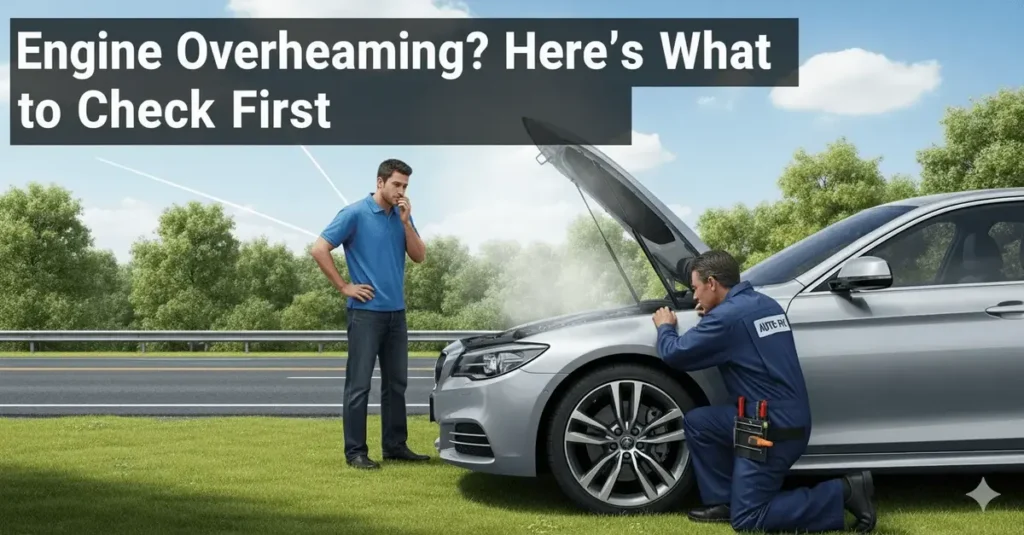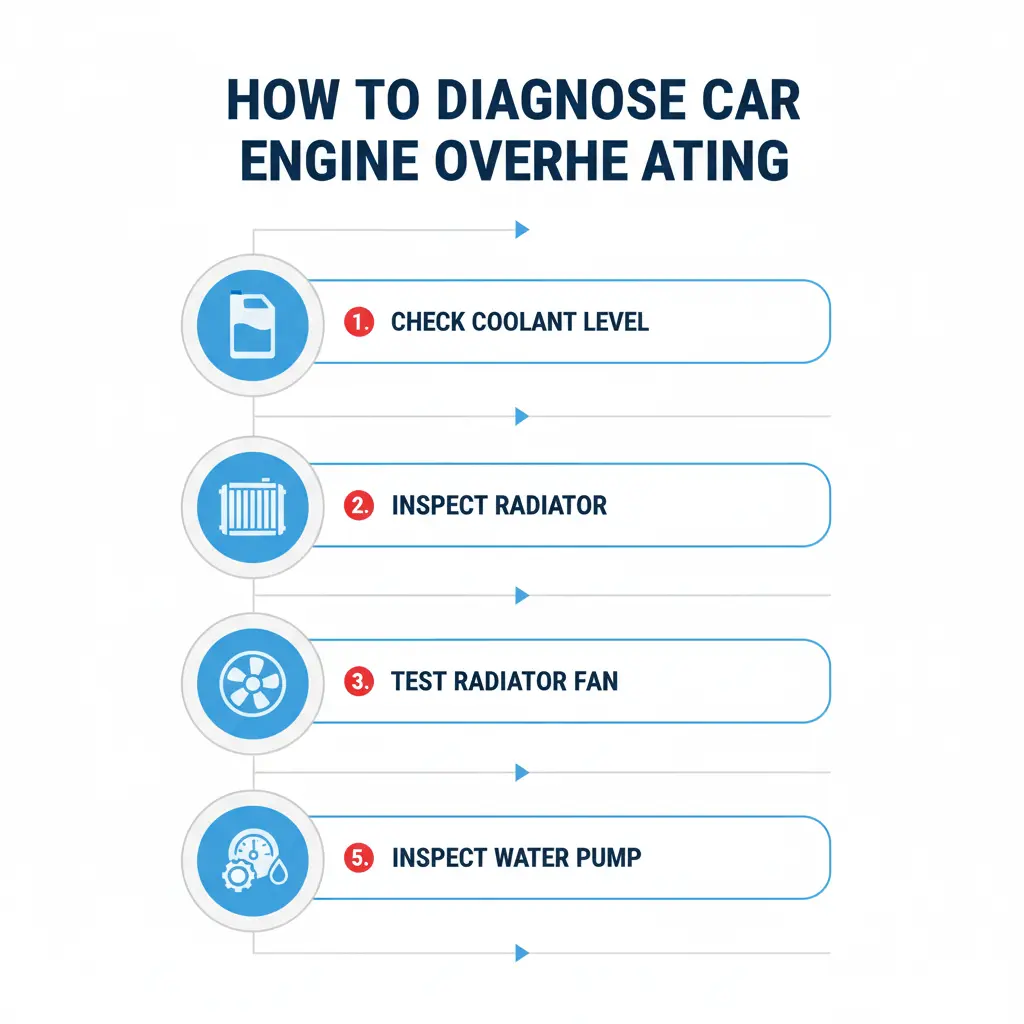
Overheating of engines is among the most frequently occurring but potentially catastrophic issues car owners confront. It can occur abruptly, turning a normal driving routine into a roadside emergency. If left untreated, it can result in severe engine damage, such as damaged cylinder heads or a cracked block, which can lead to thousands of dollars in repairs.
The good news? Many cases can be prevented or resolved with regular checks and simple maintenance. In this comprehensive guide, we’ll explore the causes of the problem, its symptoms, initial steps for detecting and correcting overheating issues, preventative strategies, and more. Whether you’re a DIYer or prefer expert assistance, knowing what to look for first will help you save time, money, and hassle.
As cars evolve and incorporate advanced cooling systems in 2025 models, such as hybrids and electric vehicles, the issue of overheating remains a universal problem. Internal combustion engines from the past dominate; however, electric cars may experience thermal issues.
Let’s get started to arm you with the skills to tackle this issue effectively.
Understanding Engine Overheating: The Basics
Overheating of the Engine occurs when the Engine’s temperature exceeds its maximum operating range, typically between 195°F and 220°F in most automobiles. The coolant can boil, generating steam, which can reduce the efficiency of the system. The cooling system, which includes the thermostat, radiator hoses, water pumps, fans, and coolant, works to disperse heat produced through combustion. If any part malfunctions, heat build-up can cause permanent damage.
In modern vehicles, sensors measure temperature and issue warnings, while older cars depend on gauges. Overheating isn’t a problem solely in summer; it can occur in winter due to frozen coolant or inadequate airflow. Being aware of early warning signs is crucial to avoiding costly breakdowns.
Common Causes of Engine Overheating
Finding the root of the issue is vital. These are the most common causes, based on experts’ knowledge and reports from mechanics:

1. Low Coolant Levels
This is the most basic, yet overlooked problem. Coolant (a mixture of antifreeze and water) absorbs heat and then transfers it from the motor. Leaks from hoses, gaskets, or radiators can reduce levels and cause excessive heat. The signs include puddles underneath the car or a pleasant smell of cooling fluid that has evaporated.
2. Faulty Thermostat
The thermostat regulates the flow of coolant. If it’s shut, coolant cannot circulate to the radiator, which can cause an extreme overheat. This is usually the case when the Engine is warm, but not immediately.
3. Radiator Problems
A damaged, clogged, or leaky radiator can impede cooling fluid flow. The accumulation of debris, corrosion, or age may cause fins to become blocked, and leaks decrease the volume of fluid. When it’s hot or there’s stop-and-go traffic, these issues can become more severe.
4. Water Pump Failure
Water pumps circulate coolant. If it fails due to wear or a damaged impeller, the flow stops, and the pump can quickly overheat. Be aware of whining sounds or look for leaks close to the pump.
5. Cooling Fan Malfunctions
Fans powered by belts or electric motors cool the radiators at very low speeds. A damaged fan motor, switch, or relay could mean there is no airflow through the traffic, which can cause excessive heat. This happens while the AC is running, as it increases loads.
6. Other Factors
- Serpentine Belt Issues: If the belt is damaged or worn out, it cannot be used to drive the water pump efficiently.
- AC overload: The conditioner at high temperatures is a strain on the system.
- Head Gasket Failure: The problem is that coolant can enter the cylinders, typically because of previous overheating.
- External Conditions: Idling in hot conditions or with heavy loads, or in extremely high temperatures.
Symptoms of an Engine Overheating
Make sure to catch these problems early to prevent the risk of escalating:
- Rise Temperature Gauge: The needle shifts towards “H” or the red zone.
- Smoke or steam coming from the Hood: It indicates the presence of boiling coolant.
- Strange Smells: sweet (coolant leak) or burnt rubber (belts), as well as hot oil.
- Engine Performance Problems: Loss of power, knocking or stopping as the Engine defends itself.
- Warning Lights: Check the engine temperature light.
- Coolant Overflow: Bubbling in the reservoir, or leaks.
If you spot any of these issues, you must act quickly to prevent engine components from warping.
What to Do Immediately When Your Engine Overheats
- Turn off the AC and turn on the heater.
- This helps pull heat away from the engine.
- Pull over safely.
- Continuing to drive can cause irreversible damage.
- Do not open the radiator cap right away.
- Hot coolant under pressure can cause severe burns. Wait until the engine cools before touching anything.
What to Check First: Step-by-Step Diagnosis Engine Overheating
In the event of an overheating incident, the safety of everyone involved is paramount. Here’s a checklist of the top priorities:
- Stop Safely: Choose a safe location free of traffic. Shut off your AC and turn on the heater to pull heat away from your Engine.
- Turn off the Engine: Let it cool for at least 30 minutes. Don’t open the cap on the radiator when it’s too hot, as it could cause burns due to pressurised steam.
- The Coolant Level: Once the coolant is removed, check the reservoir. If it is low, fill it using the correct mix of coolant. Find leaks underneath the vehicle.
- Examine Belts and Hoses: Inspect hoses and belts by rubbing them to look for wrinkles or any softness. Verify your serpentine belts for looseness, wear, or abrasion.
- Check the Radiator Fan: Begin the Engine (if secure) and verify if the fans are operating, particularly with AC turned on.
- Check the Radiator: Find blocks, damage, or an insufficient flow. Check for hot spots, which could indicate obstructions.
- Monitor for other signs: Examine the oil for an appearance that is milky (head gasket problem) or look for unusual sounds.
If this doesn’t solve the problem, then tow the automobile to a technician to get further diagnostic tests, like pressure tests.
How to Fix Common Engine Overheating Issues

- High Coolant: Fill it up and repair leaks. The system should be flushed every 4000 miles.
- Thermostat Replacement: DIY-friendly; costs between $200 and $500 professionally.
- Water Pump Repair: Often requires belt removal; expect $300-$800.
- Fan Solutions: Replace motors or relays; $100-$400.
- Radiator Flushing: $100-$200 to eliminate blocks.
Always use coolant that is OEM-spec to prevent corrosion.
Prevention Tips for Engine Overheating
Proactively maintaining your equipment is your best defence
- Make sure to check the coolant and oil levels, as well as the belts, every month.
- Schedule cooling system flushes per manufacturer guidelines.
- Avoid prolonged idleness in hot temperatures. Use shade or ventilation instead.
- Control AC usage during long trips to lessen the load.
- Check for leaks at the time of oil changes.
- For 2025 models, ensure you have the latest software for thermal management in hybrids/EVs.
These steps can prolong the life of your Engine significantly.
When to Seek Professional Help
DIY checks are excellent for the basics, but it is best to contact a professional if:
- Overheating continues after topping off the cooling fluid.
- The head gasket may have failed (white fumes from exhaust).
- The Engine won’t begin after overheating.
- Warning lights remain on.
- There’s a question about a component.
Services such as AAA, as well as roadside assistance, can offer on-site diagnostics.
FAQs
What are the most common causes of Engine overheating?
The low levels of coolant from leaks are the most common source, followed by defective radiators and thermostats.
What should I do if my Engine is running hot?
Turn off the engine safely, then allow it to cool for about 30 minutes before checking the coolant.
Does driving while overheating the engine result in permanent harm?
Yes, it may cause heads to warp, crack, or even seize the Engine. Make sure to stop immediately to reduce the risk.
What is the best way to test my coolant levels?
Every month, or before long travels. Make sure to replenish as necessary using the right mix.
Why is my car heating up just when my AC has been turned on?
It could be caused by a defective cooling fan or an overloaded compressor that is adding the heat load.
Does the engine overheating issue fall under warranty?
Most of the time, yes, for new cars. However, make sure you check your policy. Failure to maintain it could invalidate it.
Does overheating affect hybrids or electric vehicles?
Yes, although less frequent in EVs. The thermal system of the battery can get too hot, so be sure to follow the manufacturer’s recommendations.
Conclusion
An overheating engine is an indication of danger which should not be ignored. The first thing to look at is the levels of coolant along with the functioning of the radiator, as well as the operation of the fan. If the simple solutions don’t resolve the issue, seek expert assistance quickly to prevent costly damages.
Let’s say you are proactive about regular maintenance, observing your temperature gauge and knowing what you should check first to ensure that your vehicle is in good condition. In that case, you will avoid breakdowns at the time you most likely won’t.